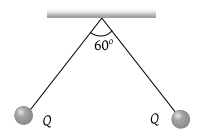A hollow insulated conducting sphere is given a positive charge of 10μC. What will be the electric field at the centre of the sphere if its radius is 2 meters
(1) Zero
(2) 5 μCm–2
(3) 20 μCm–2
(4) 8 μCm–2
An electron of mass \(m_{e}\) initially at rest, moves through a certain distance in a uniform electric field in time \(t_{1}.\) A proton of mass \(m_{p}\) also initially at rest takes time \(t_{2}\) to move through an equal distance in this uniform electric field. The ratio of \(\frac{t_{2}}{t_{1}}\) is nearly equal to- (Neglect the effect of gravity.)
1. \(1\)
2. \(\left ( \frac{m_{p}}{m_{e}} \right )^{1/2}\)
3. \(\left ( \frac{m_{e}}{m_{p}} \right )^{1/2}\)
4. \(1836\)
Point charges +4q, –q and +4q are kept on the x-axis at points x = 0, x = a and x = 2a respectively, then:
(1) only -q is in stable equilibrium.
(2) none of the charges are in equilibrium.
(3) all the charges are in unstable equilibrium.
(4) all the charges are in stable equilibrium.
Three identical positive point charges, as shown are placed at the vertices of an isosceles right-angled triangle. Which of the numbered vectors coincides in direction with the electric field at the mid-point \(M\) of the hypotenuse?

1. \(1\)
2. \(2\)
3. \(3\)
4. \(4\)
The figures below show regular hexagons, with charges at the vertices. In which of the following cases the electric field at the centre is not zero?
(1) 1
(2) 2
(3) 3
(4) 4
An electron enters an electric field with its velocity in the direction of the electric lines of force. Then:
| 1. | the path of the electron will be a circle. | 2. | the path of the electron will be a parabola. |
| 3. | the velocity of the electron will decrease. | 4. | the velocity of the electron will increase. |
Two small spherical balls each carrying a charge Q = 10 μC (10 micro-coulomb) are suspended by two insulating threads of equal lengths 1m each, from a point fixed in the ceiling. It is found that in equilibrium threads are separated by an angle 60° between them, as shown in the figure. What is the tension in the threads (Given: )
(1) 18 N
(2) 1.8 N
(3) 0.18 N
(4) None of the above
An electron having charge \(e\) and mass \(m\) is moving in a uniform electric field \(E.\) Its acceleration will be:
1. \(\dfrac{e^2}{m}\)
2. \(\dfrac{E^2e}{m}\)
3. \(\dfrac{eE}{m}\)
4. \(\dfrac{mE}{e}\)
Infinite charges of magnitude q each are lying at x =1, 2, 4, 8... meter on X-axis. The value of the intensity of the electric field at point x = 0 due to these charges will be
(1) 12 × 109q N/C
(2) Zero
(3) 6 × 109q N/C
(4) 4 × 109q N/C
A pendulum bob of mass and carrying a charge is at rest in a horizontal uniform electric field of 20000 V/m. The tension in the thread of the pendulum is
(1)
(2)
(3)
(4)









